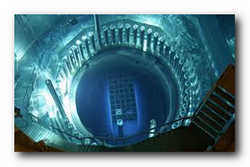 Tanks of highly radioactive liquid waste have been now cemented into drums at Dounreay – part of hazard-reduction efforts around the decommissioning of the former fast-reactor site in Scotland.
Tanks of highly radioactive liquid waste have been now cemented into drums at Dounreay – part of hazard-reduction efforts around the decommissioning of the former fast-reactor site in Scotland.
The liquid was produced during reprocessing of material test reactor (MTR) fuel at Dounreay. Spent fuel was dissolved in acid and the re-usable fuel separated from the waste, or fission products, using solvent extraction.
The acidic liquor containing the waste, known as raffinate, was transferred to underground storage tanks. It is highly radioactive, accounting for around 80% of the waste inventory at Dounreay in terms of radioactivity.
The total volume of raffinate generated was 1200 cubic metres, according to a 10 May announcement by Dounreay Site Restoration Ltd – the company in charge of the site clean-up and demolition programme
In the 1980s and early 90s, Dounreay invested in a cementation plant at Dounreay, to condition the research reactor raffinate. The Dounreay Cement Plant (DCP) has been in operation since 1996 processing the MTR raffinate.
Batches of liquor were transferred from the tanks, neutralised and mixed with cement powder inside 500-litre drums, to make it safe for long-term storage or disposal.
560 drums have been cemented during the past financial year to complete the removal of pumpable MTR raffinate from the eleven raffinate tanks. Over 4,700 drums have been generated to date with the successful cement solidification of the MTR raffinate.
To pump out the heels that have heavy solids, nitric acid is being added to the tanks. Three tanks have been completed, and two are currently being treated.
A Dounreay-devised pump system will be used to pump out the tanks that have been drained leaving a heel of approximately 750 litres, and the raffinate will be cemented into drums.
The next stage is cleaning the tanks out and Dounreay is working on a way forward.
Laboratory trials are underway to use a decontamination solution of nitric and hydrofluoric acid. The tanks will be flooded with the solution and then pumped out.
Once the tanks have been decontaminated to meet LLW criteria, they will then be removed and disposed in the new LLW facility.
